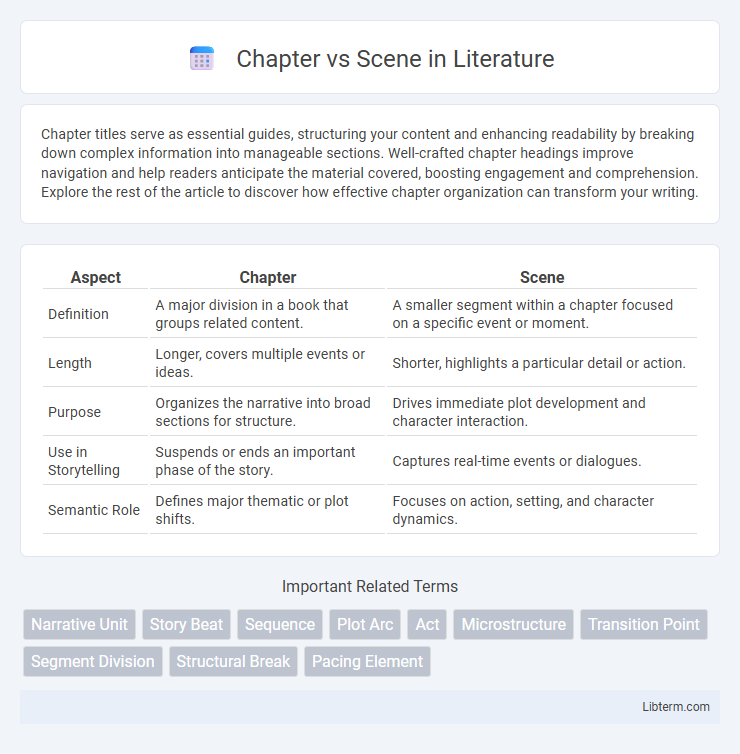Chapter titles serve as essential guides, structuring your content and enhancing readability by breaking down complex information into manageable sections. Well-crafted chapter headings improve navigation and help readers anticipate the material covered, boosting engagement and comprehension. Explore the rest of the article to discover how effective chapter organization can transform your writing.
Table of Comparison
| Aspect | Chapter | Scene |
|---|---|---|
| Definition | A major division in a book that groups related content. | A smaller segment within a chapter focused on a specific event or moment. |
| Length | Longer, covers multiple events or ideas. | Shorter, highlights a particular detail or action. |
| Purpose | Organizes the narrative into broad sections for structure. | Drives immediate plot development and character interaction. |
| Use in Storytelling | Suspends or ends an important phase of the story. | Captures real-time events or dialogues. |
| Semantic Role | Defines major thematic or plot shifts. | Focuses on action, setting, and character dynamics. |
Understanding Chapters and Scenes
Chapters structure a book by grouping related scenes to create a coherent narrative flow, providing readers with clear breaks and thematic shifts. Scenes capture specific moments or events, offering detailed settings, character actions, and dialogue that drive the story forward. Understanding the distinction between chapters and scenes helps writers organize their work for better pacing and enhanced reader engagement.
Defining a Chapter: Scope and Purpose
A chapter serves as a major division within a book, organizing content around a central theme or specific segment of the narrative to create structure and clarity. It often encompasses multiple scenes, providing broader context and guiding the overall progression of the story. Chapters help readers navigate the text by breaking the story into manageable, cohesive units with distinct purposes.
What is a Scene? Structure and Function
A scene is a fundamental narrative unit in storytelling, consisting of a continuous sequence of events occurring in a single location and time. It is structured with a clear beginning, middle, and end to drive the plot forward, reveal character development, and establish mood or tension. Scenes function to break down the story into manageable parts, creating rhythm and pacing essential for audience engagement and narrative coherence.
Key Differences Between Chapters and Scenes
Chapters serve as broader structural divisions in books, organizing content into manageable segments that often encompass multiple scenes, while scenes are smaller, focused units depicting specific moments, actions, or dialogues within a chapter. Chapters typically advance the overall narrative arc by grouping related events, whereas scenes emphasize immediate interactions or settings, providing detailed context and pacing. In storytelling, chapters guide readers through larger plot developments, whereas scenes enhance engagement through vivid, tangible experiences.
How Chapters Build Story Framework
Chapters establish the overall story framework by organizing key plot points into structured segments that guide narrative progression, pacing, and thematic development. Each chapter encapsulates specific objectives or turning points, allowing the author to build tension, reveal character growth, and maintain reader engagement through coherent storytelling. This segmentation enhances the story's clarity and flow, providing a scaffold that supports detailed scenes and subplots within the broader narrative arc.
The Role of Scenes in Narrative Flow
Scenes serve as the fundamental units of narrative flow, each encapsulating a specific event, character interaction, or moment that drives the story forward. They create pacing and rhythm by breaking the narrative into digestible segments, allowing readers to experience tension, emotion, and progression in real-time. Effective scenes maintain engagement through vivid descriptions, dynamic dialogue, and purposeful action, collectively shaping the overarching structure found in chapters.
Organizing Chapters for Maximum Impact
Organizing chapters effectively enhances narrative flow by structuring scenes to build tension and develop characters progressively. Each chapter should serve a distinct purpose, balancing pacing and thematic elements to maintain reader engagement. Strategic placement of cliffhangers or revelations at chapter ends can maximize emotional impact and prompt continued reading.
Crafting Dynamic Scenes Within Chapters
Crafting dynamic scenes within chapters requires balancing pacing and character development to maintain reader engagement. Effective scene construction involves vivid descriptions, purposeful dialogue, and seamless transitions that propel the plot forward while revealing key emotional beats. Strategic placement of scenes within chapters enhances narrative flow and builds tension, ensuring each chapter feels cohesive and compelling.
When to Start a New Chapter vs. Scene
A new chapter should start when a significant shift occurs in time, location, or perspective, providing a natural break in the narrative that resets the reader's focus. In contrast, a new scene begins within a chapter to mark a change in action or dialogue but maintains the continuity of the overall storyline. Effective transitions between chapters and scenes enhance pacing, clarify plot progression, and deepen audience engagement.
Tips for Balancing Chapters and Scenes
Balancing chapters and scenes requires clear structural planning to maintain reader engagement and pacing. Use chapters to organize major plot developments while breaking scenes into focused moments that advance specific actions or emotions. Consistent variation in chapter length and scene detail helps create a dynamic rhythm that supports storytelling flow and tension.
Chapter Infographic

 libterm.com
libterm.com